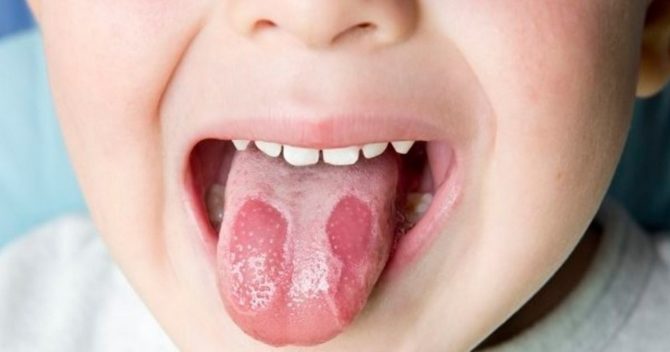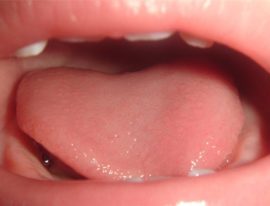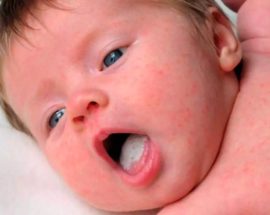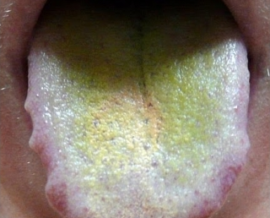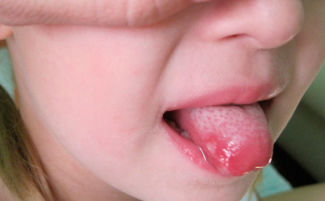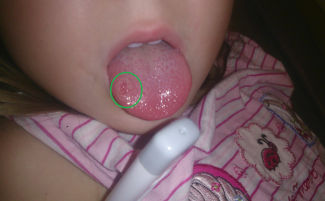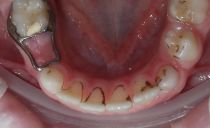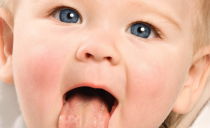Spots and plaque on the tongue in children and infants: types, causes, diagnosis and methods of treatment
The spots formed in the child’s tongue require professional diagnosis and proper treatment. Rashes can have other shades, regardless of color, they can be large with a pronounced pattern and shape or small like dots. Whatever the spots, they cannot be ignoredsince language is a litmus test of children's health.
Content
What does a normal language look like?
An experienced therapist, the color of the tongue, the shape and nature of the spots and plaque covering it, say a lot about the state of health of a small patient. Normally, the surface of the tongue should meet the following characteristics:
- saturated pink color of the mucous membrane;
- flat surface structure;
- lack of spots, plaque and other formations;
- pronounced papillae: the surface should be slightly rough.
Why do spots appear on the tongue of a baby, teenager
White, pink or other plaque, spots in the child’s tongue should become an occasion for an urgent visit to pediatric dentistry. Such signs may indicate:
- about the beginning of the development of dangerous diseases of childhood, when the success of treatment directly depends on the timeliness of diagnosis;
- about general malfunctions in the baby's body, which will require correction of metabolic processes and concomitant treatment;
- about a banal allergy to food, synthetic clothing or toys, in which it is enough to take care of strengthening the immune system and remove the allergen.
All the reasons why spots may appear on the tongue of a child are divided into three groups:
- hygienic - insufficient or improper oral care;
- somatic - diseases of an infectious / non-infectious nature;
- external - burns, mechanical damage.
Types of rashes vary in structure, color and location. In infants, young children, middle-aged children and adolescents, such shades and shapes of spots are common: white, yellow, red, dark, bald, complex shapes.
Types of plaque and the reasons for its appearance
To understand why the tongue becomes spotty, you need to look at the coating that covers it. Usually it is preceded by spots that are formed due to a violation of its structure or after the plaque “peels off”. The film on the tongue of an infant or an older child can be of such shades:
-
Thin white coating. Often observed in infants and children of the first year of life. Appears in the morning, structurally presents a thin, transparent film of whitish color. It is enough to remove deposits with a wet gauze swab so that they no longer appear during the day. Such a plaque is an allergic reaction of the baby to the artificial mixture or to the products that make up the mother’s diet (with breastfeeding).
- Cheesy white coating. A dense film of saturated white color with hidden ulcers, odorous and difficult to remove is a symptom of thrush (candidiasis) or stomatitis. In infants with such diseases, instead of a continuous coating, white spots of very impressive sizes often form.
- Yellow plaque. Formed in violation of the liver, kidneys or biliary tract of the child.
-
Gray plaque. The initial sign of formidable childhood diseases is scarlet fever and diphtheria. Sometimes this appearance of the taste organ indicates severe dehydration. In both cases, it is necessary to start treating the root cause of the symptom as soon as possible, since such diseases are dangerous not only for health, but also for the baby’s life.
- Green speckled plaque. The manifestation indicates a fungal infection of the oral cavity of a small patient. Usually the rash spreads to the palate, cheeks, and mucous membranes of the lips.
- Brown deposits. The result of a malfunction in the digestive system, accompanied by stagnation of bile in the bile ducts. In infants, the symptom often indicates dehydration, in older children a deficiency or malabsorption of B vitamins. In addition, with the appearance of brown spots in the baby’s tongue, an allergy to herbs can be suspected, even if they are taken by a nursing mother.
- Black deposits. They are the result of taking certain antibiotics, overdose or rejection of the drug by the body. Sometimes the causes of black plaque lie in intestinal disorders: colitis, enteritis and gastritis.
Types of spots and possible diagnoses
If the cause of the plaque is not eliminated, the pathological process leads to the formation of a spotted tongue in the child, sometimes the spots appear on their own. Spotted formations can have the following structure:
- Uneven plaque structure. It may be associated with epithelial exfoliation, the accumulation of microparticles of food, bacteria and their metabolic products.
- Spots that have arisen independently as a result of excessive growth of the epithelium in certain areas of the muscular organ. Pathology occurs with burns from hot food or water.
- Local inflammation due to mechanical irritation or allergies.
- Rarely, benign or malignant neoplasms on the tissues of the oral cavity.
The causes of rashes in the form of dots, circles, spots can be both insignificant and very serious, therefore, if they are found, you need to see a doctor to determine the diagnosis. Only a specialist can find out exactly what a plaque means and what disease the spots on the tongue of a child indicate.
White spots on the tongue of an infant or older child
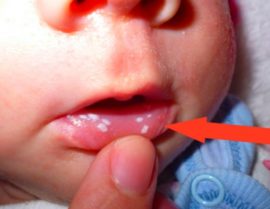 White spots on the tongue of an infant or an older baby mean the development of a fungal infection or thrush. Such spots are distinguished by a chaotic arrangement and a variety of sizes, often they are combined with a cheesy plaque.
White spots on the tongue of an infant or an older baby mean the development of a fungal infection or thrush. Such spots are distinguished by a chaotic arrangement and a variety of sizes, often they are combined with a cheesy plaque.
If such a symptom is detected, you should visit a doctor, you can’t remove the plaque yourself, since you can injure the mucous membrane.
Before visiting a doctor, you can process white spots on the tongue and other mucous membranes of the child’s mouth with a weak solution of soda or diamond greens.
Mycotic lesions of the oral cavity cause the fungus Candida albicans. Infection of a child with a fungal infection can occur from the mother, children under one year of age are especially susceptible to the disease.
In the case of infection in the baby, white dots appear on his tongue. At first, they are small, so parents may not notice the appearance of spots. With thrush, plaque and white spots appear not only on the tongue, but also on the cheeks, lips and even the inner surface of the lips.
Yellow circles
Digestion causes yellow circles. Such spots are difficult to remove from the mucous membrane and are covered with desquamated epithelium, which is why they can be periodically covered. Signs are supplemented by bad breath, itching of the affected areas is occasionally connected.
Red spots and dots on the child’s tongue
Red dots, circles, or small spots on the tongue are a symptom of infectious inflammation.:
- stomatitis or glossitis;
- dermatosis of a bacterial nature;
- herpes.
With stomatitis, the lesions are often covered with white coating, and red sores appear only with the progression of the disease. In the initial stages of herpes, the mucous membranes are also covered with whitish pimples filled with exudate. When they burst, red dots form in their place. How red spots in the child’s tongue that arose due to stomatitis can look like shown in the photo:
Unsuitable food for the child, especially bright red shades, can also lead to red rashes in the mouth. Due to inflammation, the body temperature may slightly increase, painful sensations appear in the soft tissues of the oral cavity.
Signs of herpes
Dr. Komarovsky believes that spots on the tongue of a child rarely appear due to herpes. The manifestation of this virus is the lot of adult patients, but if the symptoms manifested in the newborn, parents need to work on raising his immunity.
Symptoms:
- on the sides and on the tip of the muscular organ appear towering red spots;
- infection can affect only one side;
- contrary to popular belief, itching does not always occur.
Dr. Komarovsky does not exclude that viral spots can appear on the tongue in an infant or newborn in the first year of life. But this is possible only in two cases - the baby has already managed to get this disease, the mother of the child suffered an infection during pregnancy.
Dark dots
Dark spots may appear in the baby’s mouth after eating coloring food. Such spots and circles are easily removed after several hygienic procedures. However, there are reasons not related to coloring food, here are some of them:
- As a result of long-term antibiotic therapy, microflora was disturbed in the mouth: active growth of foreign fungi and bacteria began. Points and circles will be almost black in color, blackening will be observed for 2-3 weeks.
- Very rarely, the cause of this symptom is systemic dystrophic disorders, accompanied by the death of mucosal areas.
Bald circles or why the language "clambers"
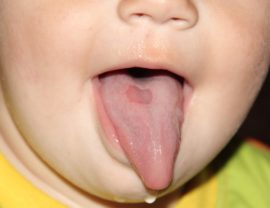 Some children experience an atrophy of the taste buds, which is accompanied by the appearance of bald spots - which is why some parents think that their child’s tongue seems to be climbing. A degenerative irreversible change in the structure of the surface of the tongue leads to the appearance of spots resembling bald patches. They are pink in color, irregular in shape, and painless.
Some children experience an atrophy of the taste buds, which is accompanied by the appearance of bald spots - which is why some parents think that their child’s tongue seems to be climbing. A degenerative irreversible change in the structure of the surface of the tongue leads to the appearance of spots resembling bald patches. They are pink in color, irregular in shape, and painless.
In most cases, dystrophy leads to:
- burns with hot food or drink;
- injuries
- stomatitis.
"Geographic language"
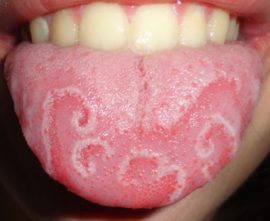 Such a pathology is characterized by the formation of large red spots with white bordering. Due to the elaborate form, vaguely reminiscent of the outlines of continents and lakes (see photo), the manifestation received such an unusual name. But in fact, he has a medical diagnosis - desquamative glossitis. There are several reasons for its formation:
Such a pathology is characterized by the formation of large red spots with white bordering. Due to the elaborate form, vaguely reminiscent of the outlines of continents and lakes (see photo), the manifestation received such an unusual name. But in fact, he has a medical diagnosis - desquamative glossitis. There are several reasons for its formation:
- violation of the digestive tract;
- helminthic infestations;
- teething.
"Geo spots" are not static: they change their location, can disappear and appear in a new location.
Experts recommend treating affected tissues with chamomile broth and a pharmacy antiseptic, however, according to Dr. Komarovsky, desquamative formations do not need treatment, since they are a symptom of a somatic disease.
Treatment of spots, circles and points on the tongue
If spots appear in the child’s tongue, specialist consultation, a full examination of the baby’s body, identification of the pathogen (if the disease is infectious), the exclusion of dangerous pathologies: scarlet fever, neoplasms, as well as fungi and viruses, is required. Therefore, all home therapy methods come down to mitigate the symptoms:
- eliminating itching, burning and pain;
- lower temperatures above 38 ° C;
- removal of the initial plaque.
In this regard, antipyretic drugs, non-hormonal anti-inflammatory drugs and light painkillers are good.If there is a suspicion of an allergic reaction, antihistamines should be given to the baby.
In addition to pharmaceuticals, before contacting a doctor, you can use chamomile broth (2 tsp. Per 200 ml of hot water) or a soda solution (2 tsp. On 250 ml of water).
Conservative treatment depends on the diagnosis made by the doctor:
- Stomatitis. The therapeutic course consists of a diet, rinsing the mouth with decoctions of herbs, local treatment of the mucosa with healing, antiseptic agents, drugs aimed at eliminating the pathogen: antibacterial, antifungal, antiviral.
- Herpes. Treatment of the affected mucosa with antiviral gels, ointments, diet, taking funds to strengthen the immune system.
- Candidiasis. Treatment of areas of the oral mucosa affected by the fungus with antifungal drugs (Candide), soda rubbing and rinsing, taking medications to increase immunity.
If the cause of plaque, red, whitish or other spots in the child’s tongue is an internal disease, it is necessary to direct all efforts to eliminate it.

